Residents of Cowley County, Kansas caused a sensation last week when they captured video of the military towing a concealed object on a flatbed truck down US Highway 77. It wasn't long before a wave of speculation hit, claiming the object was a UFO.
Depending on the angle from which you spotted it, the 30 foot-wide mysterious craft appeared to be saucer-shaped. It was so large that local law enforcement had to remove roadside signage so it could pass through. But it was covered in a tightly concealed tarp, making any further examination impossible.
~ Dec.13, 2011
A closer look...
Thursday, December 22, 2011
Mexico Mayan region launches apocalypse countdown

MEXICO CITY (AP) — Seize the day.
Only 52 weeks and a day are left before Dec. 21, 2012, when some believe the Maya predicted the end of the world.
Unlike enthusiasts of other doomsday theories who suggest putting together survival kits, southeastern Mexico, the heart of Maya territory, plans a yearlong celebration.
Mexico's tourism agency expects to draw 52 million visitors by next year only to the regions of Chiapas, Yucatan, Quintana Roo, Tabasco and Campeche. All of Mexico usually lures about 22 million foreigners in a year.

It's selling the date, the Winter Solstice in the coming year, as a time of renewal. Many archeologists argue that the 2012 reference on a 1,300-year-old stone tablet only marks the end of a cycle in the Mayan calendar.
"The world will not end. It is an era," said Yeanet Zaldo, a tourism spokeswoman for the Caribbean state of Quintana Roo, home to Cancun. "For us, it is a message of hope."

Cities and towns in the Mayan region on Wednesday will start the yearlong countdown. In Chiapas the town of Tapachula on the Guatemalan border will start a countdown on an 8-foot digital clock in the main park exactly a year before the mysterious date.
In the nearby archaeological site of Izapa, Maya priests will burn incense, chant and offer prayers.
In the tropical jungle of Quintana Roo, between the resorts of Cancun and Playa del Carmen, people are putting messages and photos in a time capsule that will be buried for 50 years. Maya priests and Indian dancers will perform a ritual at the time capsule ceremony.

Yucatan state has announced plans to complete the Maya Museum of Merida by next summer.
"People who still live in Mayan villages will host rites and burn incense for us to go back in time and try to understand the Mayan wisdom," Zaldo said.
The Maya reputation for wisdom has people taking the alleged prediction seriously.
The Mayan civilization, which reached its height from 300 A.D. to 900 A.D., had a talent for astronomy
Its Long Count calendar begins in 3,114 B.C., marking time in roughly 394-year periods known as Baktuns. Thirteen was a significant, sacred number for the Mayas, and they wrote that the 13th Baktun ends on Dec. 21, 2012.
The doomsday theories stem from a stone tablet discovered in the 1960s at the archaeological site of Tortuguero in the Gulf of Mexico state of Tabasco that describes the return of a Mayan god at the end of a 13th period.
Believers have taken the end-of-the world fears to the Internet with hundreds of thousands of websites and blogs.
"The Maya are viewed by many westerners as exotic folks that were supposed to have had some special, secret knowledge," said Mayan scholar Sven Gronemeyer. "What happens is that our expectations and fears get projected on the Maya calendar."
Gronemeyer of La Trobe University in Australia compares the supposed Mayan prophecies to the "Y2K" hype, when people feared all computer systems would crash when the new millennium began on Jan. 1, 2000.
For some reason, Gronemeyer says, people have ignored evidence that dates beyond 2012 were recorded.
The blogosphere exploded with more speculation when Mexico's archaeology institute acknowledged on Nov. 24 a second reference to Dec. 21, 2012, on a brick found at other ruins.
"Human beings seem to be attracted by apocalyptic ideas and always assume the worst," Gronemeyer said.
It's all a bit frustrating for serious Mayan researchers whose field has made huge strides in recent years.
"This new historical and archaeological knowledge is so much more interesting and mind-blowing than the fantastical claims about Maya prophecies one sees on TV, books or on the Internet," David Stuart, a specialist in Mayan epigraphy at the University of Texas at Austin, said in an email to The Associated Press. "We're dealing with thousands of newly deciphered texts and trying to weave together a coherent picture of Maya history and culture, which to me is as exciting as it gets."
While the 2012 hype might increase interest in the Maya, "that will probably be offset by the long and difficult effort ahead to correct the ubiquitous lies and misconceptions, even after 2012 has come and gone," he wrote.
Jonnie Channell of Albuquerque, New Mexico, says that 2012 "is going to be one of those things where people are definitely going to have to plan," not because of impending apocalypse, but because hotel rooms in the Maya region are probably going to be full.
Channell, who owns Maya Sites Travel Services, is surprised that she already has 24 reservations for three tour packages she is offering to major Mayan ruin sites in the week leading up to the solstice.
She named one "Beginning the New Calendar Era Under the Yucatan Stars."
"We put together these tours, and we've got lots of signups, and people are excited about it," she said. "If anybody think it's going to be the end of the world, then they better stay home."

By ADRIANA GOMEZ LICON | AP – Wed, Dec 21, 2011
Associated Press writer Mark Stevenson contributed to this report
Wednesday, December 21, 2011
First Earth-sized planets found beyond solar system
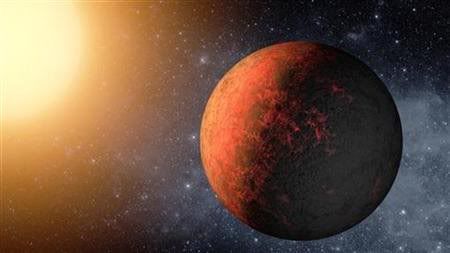
~ An artist's rendering shows a planet called Kepler-20e in this handout released December 20, 2011.
Article By Irene Klotz
CAPE CANAVERAL, Florida (Reuters) - Astronomers have found a pair of Earth-sized planets orbiting a star similar to the sun, though neither are believed to be suitable for life, scientists on NASA's Kepler telescope team said on Tuesday.
The discovery follows confirmation earlier this month of a super-Earth sized planet, called Kepler-22b, that circles the right distance from its parent star for liquid water to exist on its surface. Water is believed to be a key ingredient for life.
"Kepler-22b has the right temperature, but it is too big. (The planets) we're announcing today are just the right size, but too hot," astronomer David Charbonneau with Harvard University, told reporters during a conference call.
"But you can bet that the hunt is on to find a planet that combines the best of both worlds, a true Earth twin," he said.
The newly discovered planets, called Kepler-20e and 20f, have at least three gas-giant siblings, one of the larger planetary systems found to date.
But the family is nothing like our solar system, where rocky worlds like Venus, Earth and Mars are grouped together closer in toward the sun while gas giants like Jupiter and Saturn are segregated in the outer regions.
The two Earth-like and three Neptune-sized planets in the Kepler-20 family are interspersed and all orbit closer to the parent star than our solar system's innermost planet, Mercury.
"Rocky planets and gas giants happily mingle together. This is the first time we've seen anything like this," Charbonneau said.
Kepler-20e and 20f, which are believed to be too hot for liquid water, probably are not habitable - at least not today.
"If Kepler-20f was formed with water, which I think is likely, then it could have held on to its water for several billions of years ," said astronomer Linda Elkins-Tanton with the Carnegie Institute in Washington D.C.
"And that means that this planet could have been habitable in the past for a long period," she said.
The system is located about 1,000 light-years away in the constellation Lyra.
Light travels at about 299,337 km per second.
(Editing by Kevin Gray and Sandra Maler)
Wednesday, September 28, 2011
Treasure hunters eye huge silver haul from WWII ship
Source from AFP News :
When the SS Gairsoppa was torpedoed by a German U-boat 70 years ago, it took its huge silver cargo to a watery grave. US divers are working to recover what may be the biggest shipwreck haul ever, valued at some $210 million.
Florida-based Odyssey Marine Exploration on Monday confirmed the identity and location of the Gairsoppa, and cited official documents indicating the British ship was carrying some 219 tons of silver when it sank in 1941 in the North Atlantic some 300 miles (490 kilometers) off the Irish coast.
Valued then at 600,000 pounds, the silver today is worth about $210 million, which would make it history's largest recovery of precious metals lost at sea, Odyssey said.
"We've accomplished the first phase of this project -- the location and identification of the target shipwreck -- and now we're hard at work planning for the recovery phase," Odyssey senior project manager Andrew Craig said in a statement.
"Given the orientation and condition of the shipwreck, we are extremely confident that our planned salvage operation will be well suited for the recovery of this silver cargo."
Recovery is expected to begin next spring.
After a competitive tender process the British government awarded Odyssey an exclusive salvage contract for the cargo, and under the agreement Odyssey will retain 80 percent of the silver bullion salvaged from the wreck.
The 412-foot (125-meter) Gairsoppa had been sailing from India back to Britain in February 1941 bearing a cargo of silver, pig iron and tea, and was in a convoy of ships when a storm hit. Running low on fuel, the Gairsoppa broke off from the convoy and set a course for Galway, Ireland.
It never made it, succumbing to a German torpedo in the contested waters of the North Atlantic. Of the 85 people on board, only one survived.
The Gairsoppa came to rest nearly 15,400 feet (4,700 meters) below the surface, where for decades it was lost to the world. A previous effort to locate the shipwreck failed.
Odyssey found it relatively quickly, and insists the depth of the site won't prevent a full cargo recovery.
"We were fortunate to find the shipwreck sitting upright, with the holds open and easily accessible," Odyssey chief executive Greg Stemm said.
"This should enable us to unload cargo through the hatches as would happen with a floating ship alongside a cargo terminal."
Odyssey is a world leader in deep-ocean exploration and has numerous shipwreck hunting projects in process around the globe.
In May 2007, it announced it had found half a million silver coins and hundreds of gold objects from a ship they code-named the "Black Swan," which went down in 1804 in the Atlantic off the Strait of Gibraltar. The find is being contested by Spain, which claims the trove.
In the latest operation, the firm recently conducted remotely operated vehicles from its main ship, the Odyssey Explorer, to inspect the Gairsoppa wreck. It acquired still and video imagery from the site which were used to confirm the identify and evaluate the condition of the ship.

~ Handout image courtesy of the Odyssey Marine Exploration shows a stern compass of the SS Gairsoppa on the top of the poop deck
Photographs released by the company show clear details of the Gairsoppa, including a ladder leading to the forecastle deck, a waist-high compass used by the helmsman, even the hole in the steel hull blown open by the torpedo.
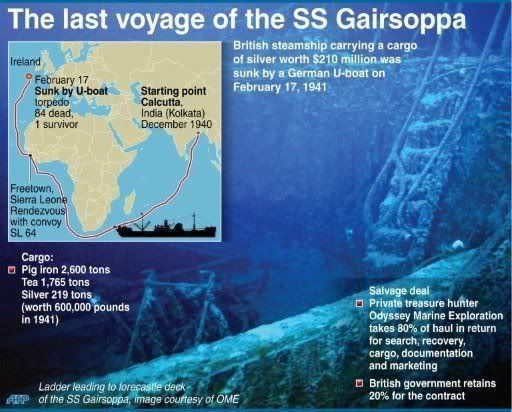
~ Graphic on the last voyage of the SS Gairsoppa, torpedoed by a German U-boat in World War II, carrying 219 tons of silver. Florida-based company Odyssey Marine Exploration is working to recover the treasures.
The find highlights the influential role that modern technology has come to play in the business of finding shipwrecks, with vastly improved sonar equipment, global positioning systems and advanced deepwater robots that scour the world's oceans for booty.
UNESCO estimates there are some three million shipwrecks worldwide, with billions of dollars in sunken treasures and priceless knowledge that can be recovered from the depths of the ocean, including vast amounts of naturally occurring copper, silver, gold and zinc deposits waiting to be discovered
"The majority of the world's ocean floor has not yet been explored," said Odyssey president Mark Gordon, who told AFP that the discovery at some 4,700 meters (15,400 feet) beneath below the ocean's surface is a treasure trove for companies like his.
"We know more about the surface of the moon than we know about the deepest parts of the oceans. It's exciting to be working at depths like these and to be among the pioneers of deep ocean exploration in this unexplored frontier."
When the SS Gairsoppa was torpedoed by a German U-boat 70 years ago, it took its huge silver cargo to a watery grave. US divers are working to recover what may be the biggest shipwreck haul ever, valued at some $210 million.
Florida-based Odyssey Marine Exploration on Monday confirmed the identity and location of the Gairsoppa, and cited official documents indicating the British ship was carrying some 219 tons of silver when it sank in 1941 in the North Atlantic some 300 miles (490 kilometers) off the Irish coast.
Valued then at 600,000 pounds, the silver today is worth about $210 million, which would make it history's largest recovery of precious metals lost at sea, Odyssey said.
"We've accomplished the first phase of this project -- the location and identification of the target shipwreck -- and now we're hard at work planning for the recovery phase," Odyssey senior project manager Andrew Craig said in a statement.
"Given the orientation and condition of the shipwreck, we are extremely confident that our planned salvage operation will be well suited for the recovery of this silver cargo."
Recovery is expected to begin next spring.
After a competitive tender process the British government awarded Odyssey an exclusive salvage contract for the cargo, and under the agreement Odyssey will retain 80 percent of the silver bullion salvaged from the wreck.
The 412-foot (125-meter) Gairsoppa had been sailing from India back to Britain in February 1941 bearing a cargo of silver, pig iron and tea, and was in a convoy of ships when a storm hit. Running low on fuel, the Gairsoppa broke off from the convoy and set a course for Galway, Ireland.
It never made it, succumbing to a German torpedo in the contested waters of the North Atlantic. Of the 85 people on board, only one survived.
The Gairsoppa came to rest nearly 15,400 feet (4,700 meters) below the surface, where for decades it was lost to the world. A previous effort to locate the shipwreck failed.
Odyssey found it relatively quickly, and insists the depth of the site won't prevent a full cargo recovery.
"We were fortunate to find the shipwreck sitting upright, with the holds open and easily accessible," Odyssey chief executive Greg Stemm said.
"This should enable us to unload cargo through the hatches as would happen with a floating ship alongside a cargo terminal."
Odyssey is a world leader in deep-ocean exploration and has numerous shipwreck hunting projects in process around the globe.
In May 2007, it announced it had found half a million silver coins and hundreds of gold objects from a ship they code-named the "Black Swan," which went down in 1804 in the Atlantic off the Strait of Gibraltar. The find is being contested by Spain, which claims the trove.
In the latest operation, the firm recently conducted remotely operated vehicles from its main ship, the Odyssey Explorer, to inspect the Gairsoppa wreck. It acquired still and video imagery from the site which were used to confirm the identify and evaluate the condition of the ship.

~ Handout image courtesy of the Odyssey Marine Exploration shows a stern compass of the SS Gairsoppa on the top of the poop deck
Photographs released by the company show clear details of the Gairsoppa, including a ladder leading to the forecastle deck, a waist-high compass used by the helmsman, even the hole in the steel hull blown open by the torpedo.

~ Graphic on the last voyage of the SS Gairsoppa, torpedoed by a German U-boat in World War II, carrying 219 tons of silver. Florida-based company Odyssey Marine Exploration is working to recover the treasures.
The find highlights the influential role that modern technology has come to play in the business of finding shipwrecks, with vastly improved sonar equipment, global positioning systems and advanced deepwater robots that scour the world's oceans for booty.
UNESCO estimates there are some three million shipwrecks worldwide, with billions of dollars in sunken treasures and priceless knowledge that can be recovered from the depths of the ocean, including vast amounts of naturally occurring copper, silver, gold and zinc deposits waiting to be discovered
"The majority of the world's ocean floor has not yet been explored," said Odyssey president Mark Gordon, who told AFP that the discovery at some 4,700 meters (15,400 feet) beneath below the ocean's surface is a treasure trove for companies like his.
"We know more about the surface of the moon than we know about the deepest parts of the oceans. It's exciting to be working at depths like these and to be among the pioneers of deep ocean exploration in this unexplored frontier."
Friday, September 23, 2011
Japan noodle museum opens doors
Japan's Nissin Foods opened a cup noodle museum on Saturday charting the history of the speedy snack where visitors even get the chance to create their own tasty version.
About 500 adults and children queued up before the museum opened in the port city of Yokohama near Tokyo with celebrity guests ranging from a former prime minister to a retail business tycoon.
"We opened this place... as a factory that gives children experience and a museum for corporate activities," Nissin Foods Holdings president Koki Ando said.
Ando, whose late father Momofuku Ando invented instant noodles more than half a century ago, said visitors could knead flour, roll out noodles, steam and fry them to make chicken ramen which is then put into bags.
Children in aprons set to work making noodles under the watchful gaze of guests including former prime minister Junichiro Koizumi, Japanese premier from 2001-2006.
In another area of the museum called "My Cup Noodle Factory", visitors can design cups, put dried noodles in them and pick toppings and broth for their own versions of cupped meals -- with the potential to create more than 5,000 different versions.
The museum exhibits packages of Nissin instant noodles from around the world over the decades and houses restaurants that serve food such as Vietnamese pho noodles and pasta from Italy.
There are giant cup noodle containers in the museum for children to play in.
Momofuku Ando, the man credited with inventing instant noodles, took a lower-profile role in the business at the ripe old age of 95 in 2005, the year Nissin supplied vacuum packed instant noodles or "Space Ram" to a Japanese astronaut aboard a US space shuttle.
Ando died of acute heart failure in 2007.
The businessman, born in 1910 in Taiwan under Japanese occupation, entered the food business when Japan was hungry after World War II and invented the world's first instant noodles, chicken ramen noodles sold in bags, in 1958.
He launched the cupped version in 1971 with a pre-cooked slab of noodles in a waterproof styrofoam container.
Ando saw his invention stocked on the shelves of convenience stores around the world.
As the products were widely replicated, more than 95 billion servings were consumed around the globe in 2010, according to the Japanese instant noodles manufacturers' association.
Ando said he was inspired to develop the product when he saw a long line of people waiting to buy soup noodles at a black market stall in post-war Japan.
"Peace prevails when food suffices," he was quoted as saying.
The museum is Nissin's second devoted to instant noodles after one opened in the western Japan province of Osaka in 1999.
The multi-storey Yokohama museum has a total floor space of 10,000 square metres (107,600 square feet) -- three times bigger than the Osaka museum.
By Yoshikazu Tsuno | AFP News – Sat, Sep 17, 2011
About 500 adults and children queued up before the museum opened in the port city of Yokohama near Tokyo with celebrity guests ranging from a former prime minister to a retail business tycoon.
"We opened this place... as a factory that gives children experience and a museum for corporate activities," Nissin Foods Holdings president Koki Ando said.
Ando, whose late father Momofuku Ando invented instant noodles more than half a century ago, said visitors could knead flour, roll out noodles, steam and fry them to make chicken ramen which is then put into bags.
Children in aprons set to work making noodles under the watchful gaze of guests including former prime minister Junichiro Koizumi, Japanese premier from 2001-2006.
In another area of the museum called "My Cup Noodle Factory", visitors can design cups, put dried noodles in them and pick toppings and broth for their own versions of cupped meals -- with the potential to create more than 5,000 different versions.
The museum exhibits packages of Nissin instant noodles from around the world over the decades and houses restaurants that serve food such as Vietnamese pho noodles and pasta from Italy.
There are giant cup noodle containers in the museum for children to play in.
Momofuku Ando, the man credited with inventing instant noodles, took a lower-profile role in the business at the ripe old age of 95 in 2005, the year Nissin supplied vacuum packed instant noodles or "Space Ram" to a Japanese astronaut aboard a US space shuttle.
Ando died of acute heart failure in 2007.
The businessman, born in 1910 in Taiwan under Japanese occupation, entered the food business when Japan was hungry after World War II and invented the world's first instant noodles, chicken ramen noodles sold in bags, in 1958.
He launched the cupped version in 1971 with a pre-cooked slab of noodles in a waterproof styrofoam container.
Ando saw his invention stocked on the shelves of convenience stores around the world.
As the products were widely replicated, more than 95 billion servings were consumed around the globe in 2010, according to the Japanese instant noodles manufacturers' association.
Ando said he was inspired to develop the product when he saw a long line of people waiting to buy soup noodles at a black market stall in post-war Japan.
"Peace prevails when food suffices," he was quoted as saying.
The museum is Nissin's second devoted to instant noodles after one opened in the western Japan province of Osaka in 1999.
The multi-storey Yokohama museum has a total floor space of 10,000 square metres (107,600 square feet) -- three times bigger than the Osaka museum.
By Yoshikazu Tsuno | AFP News – Sat, Sep 17, 2011
Wednesday, September 21, 2011
Amazing Timelapse of Earth
Science educator James Drake built this amazing timelapse video from the perspective of the International Space Station as it flew over North and South America.
He created this video by downloading a series of 600 photographs that were available online at the Gateway to Astronomy Photograph of Earth, and then stitching them together into a complete video.
Amazing volcanic activity seen from space

This May 23, 2006, photo released by NASA shows the eruption of Cleveland Volcano, Aleutian Islands, Alaska, as photographed by an Expedition 13 crew member on the International Space Station. The image captures the ash plume of the very short-lived eruption.
Photo Courtesy of Earth Sciences and Image Analysis Laboratory, NASA Johnson Space Center
Japanese girl delighted by bottle found in Hawaii
By MARI YAMAGUCHI , Sep 18, 2011
TOKYO (AP) — A Japanese teenager expressed her gratitude Sunday after a U.S. sailor in Hawaii found a bottle she had tossed into the sea off Japan's southern coast as a child, and said she was delighted to be reconnected with her old classmates as a result.
Saki Arikawa, 17, said she had almost forgotten about the bottle and initially couldn't believe it was found after five years.
In a telephone interview with The Associated Press from her hometown in Kagoshima, she said "it's a miracle" the bottle was found. "It's incredible," she said.
The clear glass bottle was found Thursday by Navy Petty Officer Jon Moore during a beach cleanup at the Pacific Missile Range Facility on Kauai island.
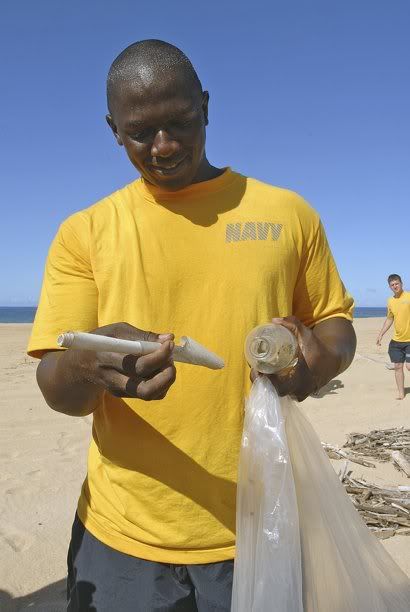
~ U.S. Navy electrician's Mate 2nd Class Jon Moore removes a message from a bottle sent from Kagoshima, Japan more than five years ago
The bottle contained four origami cranes — symbols of peace in Japan — as well as a photo of Arikawa's elementary school class and a note dated March 25, 2006, and signed by Arikawa saying she wanted it to be "a graduation memory."

~ A photo of 6th grade students from Kagoshima, Japan found in a bottle by Petty Officer Jon Moore during a cleanup on a beach at the Pacific Missile Range Facility on Kauai Island
News of the bottle's recovery reconnected more than a dozen of her old classmates, now studying at different high schools, and their elementary school homeroom teacher for a reunion Saturday. Arikawa says she now wants to further expand the circle of friendship.
"Thanks to the bottle, some of us could get together and had a great time," she said. "Now I'd like to meet the person who kindly saved my bottle."
The bottle was one of five she tossed into the ocean in 2006 as her sixth-grade class graduated from Kokubu Elementary School in Kagoshima. She and her 31 classmates dropped five bottles each, including the one that turned up last week.
Three other bottles had previously been recovered, including two in Alaska and a third at another location in Hawaii.
The Navy said Moore was among 40 base personnel and 16 students and faculty from a Kauai school who picked up beach trash in observance of International Coastal Cleanup Day.
TOKYO (AP) — A Japanese teenager expressed her gratitude Sunday after a U.S. sailor in Hawaii found a bottle she had tossed into the sea off Japan's southern coast as a child, and said she was delighted to be reconnected with her old classmates as a result.
Saki Arikawa, 17, said she had almost forgotten about the bottle and initially couldn't believe it was found after five years.
In a telephone interview with The Associated Press from her hometown in Kagoshima, she said "it's a miracle" the bottle was found. "It's incredible," she said.
The clear glass bottle was found Thursday by Navy Petty Officer Jon Moore during a beach cleanup at the Pacific Missile Range Facility on Kauai island.

~ U.S. Navy electrician's Mate 2nd Class Jon Moore removes a message from a bottle sent from Kagoshima, Japan more than five years ago
The bottle contained four origami cranes — symbols of peace in Japan — as well as a photo of Arikawa's elementary school class and a note dated March 25, 2006, and signed by Arikawa saying she wanted it to be "a graduation memory."

~ A photo of 6th grade students from Kagoshima, Japan found in a bottle by Petty Officer Jon Moore during a cleanup on a beach at the Pacific Missile Range Facility on Kauai Island
News of the bottle's recovery reconnected more than a dozen of her old classmates, now studying at different high schools, and their elementary school homeroom teacher for a reunion Saturday. Arikawa says she now wants to further expand the circle of friendship.
"Thanks to the bottle, some of us could get together and had a great time," she said. "Now I'd like to meet the person who kindly saved my bottle."
The bottle was one of five she tossed into the ocean in 2006 as her sixth-grade class graduated from Kokubu Elementary School in Kagoshima. She and her 31 classmates dropped five bottles each, including the one that turned up last week.
Three other bottles had previously been recovered, including two in Alaska and a third at another location in Hawaii.
The Navy said Moore was among 40 base personnel and 16 students and faculty from a Kauai school who picked up beach trash in observance of International Coastal Cleanup Day.
Tuesday, September 20, 2011
200-year-old letter by Raffles on Singpore
By Philip Lim @ 19/9/2011
A nearly illegible letter from almost two centuries ago is kept in a dim, cold room in downtown Singapore accessible only to a privileged few via an electronic swipe card.
In flowing script dated June 9, 1819, Singapore's colonial founder Stamford Raffles described the island's formative days as a regional trading port in the Malay archipelago, and it turned out to be prophetic.
"The Settlement I had the satisfaction to form in this very centrical and commanding station has had every success ... our Port is already crowded with shipping from all the native Ports in the Archipelago," he wrote.
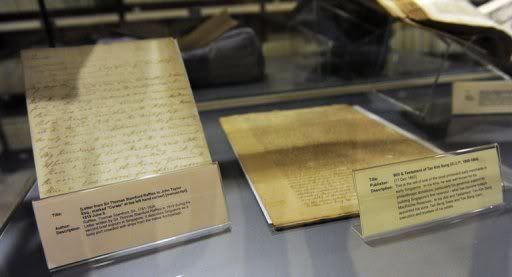
~ letters from centuries ago displayed in a room that is home to the Rare Materials Collection (RMC) of Singapore's National Library.
The letter, as well as some 7,000 other items in the room, form the Rare Materials Collection (RMC) of Singapore's National Library, offering a more intimate look into the past of what is now one of the world's busiest ports.
"The history textbook doesn't cover everything," senior librarian Ong Eng Chuan told an AFP reporter who was allowed briefly into the chamber.
"The RMC gives you an interesting perspective of Singapore, from a small fishing village to an international trading port," Ong told AFP.
"It offers an interesting window for the generation now to look into Singapore, and how it has developed into the current place that it is now."
Stepping into the RMC may seem rather underwhelming at first as nondescript boxes containing books and documents sit neatly on shelves with no indication of their historical importance.
The boxes -- made from acid-free paper -- as well as the 18-20 degree celsius (64-68 degree Fahrenheit) temperature, 50-55 percent humidity and dim lighting are necessary to prevent the collection from degrading, Ong said.
People allowed to handle the documents have to wear gloves.
"Some of our hands might have sweat, and the moisture is not good for the paper," he said.
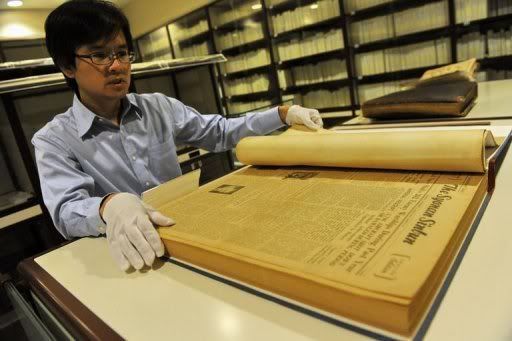
~Senior librarian Ong Eng Chuan flipping through the pages of old newspaper Syonan Sinbun, on display in the Rare Materials Collection (RMC) of Singapore's National Library
Physical access to the RMC is strictly limited on a "case-by-case basis," with librarians routinely referring people asking to view the collection to digital versions posted on the library's website.
Anyone asking to see the real collection needs a pretty good reason.
"Seeing the actual item has an X factor that can make it more interesting for the people, but we have to balance the need to preserve the item and the need to provide access to the content," Ong said.
Publications kept by the RMC include European travelogues from as early as 1577, biographical accounts of daily life in Malaya and even love poems and cookbooks from a hundred years ago.
"The Mem's Own Cookery Book" -- meant for the wives of British administrators who established colonies around Asia at the time -- features recipes to suit the tastebuds of homesick Englishmen.
Recipes for spinach soup, roast hare and pigeon mingle with tips for more adventurous fare like jungle deer curry and sheep head broth.
In contrast, the "Hikayat Abdullah," an 1849 biography of the father of modern Malay literature Munshi Abdullah, offered a unique perspective often missing from records largely penned by Western authors, librarian Ong said.
"It offers an Asian perspective in contrast to the accounts you see from the East India company's records and the memoirs written by those officials," he stated.
In the biography, Abdullah praises Raffles -- who had employed him as a translator -- but offered a less than complimentary description of British sailors who docked in his hometown Malacca, now part of Malaysia.
"To see an Englishman was like seeing a tiger, because they were so mischievous and violent... At that time I never met an Englishman who had a white face, for all of them had 'mounted the green horse', that is to say, were drunk," he wrote.
"So much so that when children cried their mothers would say, 'Be quiet, the drunken Englishman is coming,' and the children would be scared, and keep quiet."
John Solomon, a postgraduate student from Australia's University of New South Wales, accessed the RMC twice for his research on 19th-century transmarine convicts sent to Singapore.
"As a historian, I enjoy being able to physically handle material from the period. It gives the past this powerful sense of immediacy and presence," he said.
"Being in contact with the physical material also makes me realise that Singapore's story is not merely an account of economic and social policies but is also enmeshed in the everyday struggles and triumphs of individuals from vastly different circumstances."
A nearly illegible letter from almost two centuries ago is kept in a dim, cold room in downtown Singapore accessible only to a privileged few via an electronic swipe card.
In flowing script dated June 9, 1819, Singapore's colonial founder Stamford Raffles described the island's formative days as a regional trading port in the Malay archipelago, and it turned out to be prophetic.
"The Settlement I had the satisfaction to form in this very centrical and commanding station has had every success ... our Port is already crowded with shipping from all the native Ports in the Archipelago," he wrote.

~ letters from centuries ago displayed in a room that is home to the Rare Materials Collection (RMC) of Singapore's National Library.
The letter, as well as some 7,000 other items in the room, form the Rare Materials Collection (RMC) of Singapore's National Library, offering a more intimate look into the past of what is now one of the world's busiest ports.
"The history textbook doesn't cover everything," senior librarian Ong Eng Chuan told an AFP reporter who was allowed briefly into the chamber.
"The RMC gives you an interesting perspective of Singapore, from a small fishing village to an international trading port," Ong told AFP.
"It offers an interesting window for the generation now to look into Singapore, and how it has developed into the current place that it is now."
Stepping into the RMC may seem rather underwhelming at first as nondescript boxes containing books and documents sit neatly on shelves with no indication of their historical importance.
The boxes -- made from acid-free paper -- as well as the 18-20 degree celsius (64-68 degree Fahrenheit) temperature, 50-55 percent humidity and dim lighting are necessary to prevent the collection from degrading, Ong said.
People allowed to handle the documents have to wear gloves.
"Some of our hands might have sweat, and the moisture is not good for the paper," he said.

~Senior librarian Ong Eng Chuan flipping through the pages of old newspaper Syonan Sinbun, on display in the Rare Materials Collection (RMC) of Singapore's National Library
Physical access to the RMC is strictly limited on a "case-by-case basis," with librarians routinely referring people asking to view the collection to digital versions posted on the library's website.
Anyone asking to see the real collection needs a pretty good reason.
"Seeing the actual item has an X factor that can make it more interesting for the people, but we have to balance the need to preserve the item and the need to provide access to the content," Ong said.
Publications kept by the RMC include European travelogues from as early as 1577, biographical accounts of daily life in Malaya and even love poems and cookbooks from a hundred years ago.
"The Mem's Own Cookery Book" -- meant for the wives of British administrators who established colonies around Asia at the time -- features recipes to suit the tastebuds of homesick Englishmen.
Recipes for spinach soup, roast hare and pigeon mingle with tips for more adventurous fare like jungle deer curry and sheep head broth.
In contrast, the "Hikayat Abdullah," an 1849 biography of the father of modern Malay literature Munshi Abdullah, offered a unique perspective often missing from records largely penned by Western authors, librarian Ong said.
"It offers an Asian perspective in contrast to the accounts you see from the East India company's records and the memoirs written by those officials," he stated.
In the biography, Abdullah praises Raffles -- who had employed him as a translator -- but offered a less than complimentary description of British sailors who docked in his hometown Malacca, now part of Malaysia.
"To see an Englishman was like seeing a tiger, because they were so mischievous and violent... At that time I never met an Englishman who had a white face, for all of them had 'mounted the green horse', that is to say, were drunk," he wrote.
"So much so that when children cried their mothers would say, 'Be quiet, the drunken Englishman is coming,' and the children would be scared, and keep quiet."
John Solomon, a postgraduate student from Australia's University of New South Wales, accessed the RMC twice for his research on 19th-century transmarine convicts sent to Singapore.
"As a historian, I enjoy being able to physically handle material from the period. It gives the past this powerful sense of immediacy and presence," he said.
"Being in contact with the physical material also makes me realise that Singapore's story is not merely an account of economic and social policies but is also enmeshed in the everyday struggles and triumphs of individuals from vastly different circumstances."
Monday, September 19, 2011
Japanese Tsunami Viewed From A Car
Yu Muroga is a Japanese driver. It was his tour took place when the earthquake March 11, 2011. Like most people of his area, he did not feel threatened by the tsumani, as it was far enough from the coast. So he continued to drive and do its job. The HD camera mounted on the dashboard has not only captured the shock but also the moments that followed, where many drivers were stranded by the waters of the tsunami.
Note : The "Dancing" man at the road junction is due to EARTHQUAKE (ground shaking)
Note : The "Dancing" man at the road junction is due to EARTHQUAKE (ground shaking)
Visible Only From Above, Mystifying 'Nazca Lines' Discovered in Mideast
By Owen Jarus | LiveScience.com – Thu, Sep 15, 2011
The giant stone structures form wheel shapes with spokes often radiating inside. Here a cluster of wheels in the Azraq Oasis. CREDIT: David D. Boyer
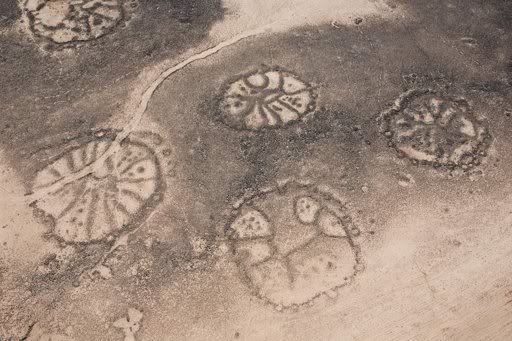
They stretch from Syria to Saudi Arabia, can be seen from the air but not the ground, and are virtually unknown to the public.
They are the Middle East's own version of the Nazca Lines — ancient "geolyphs," or drawings, that span deserts in southern Peru — and now, thanks to new satellite-mapping technologies, and an aerial photography program in Jordan, researchers are discovering more of them than ever before. They number well into the thousands.
Referred to by archaeologists as "wheels," these stone structures have a wide variety of designs, with a common one being a circle with spokes radiating inside. Researchers believe that they date back to antiquity, at least 2,000 years ago. They are often found on lava fields and range from 82 feet to 230 feet (25 meters to 70 meters) across. [See gallery of wheel structures]
"In Jordan alone we've got stone-built structures that are far more numerous than (the) Nazca Lines, far more extensive in the area that they cover, and far older," said David Kennedy, a professor of classics and ancient history at the University of Western Australia.
Kennedy's new research, which will be published in a forthcoming issue of the Journal of Archaeological Science, reveals that these wheels form part of a variety of stone landscapes. These include kites (stone structures used for funnelling and killing animals); pendants (lines of stone cairns that run from burials); and walls, mysterious structures that meander across the landscape for up to several hundred feet and have no apparent practical use.
His team's studies are part of a long-term aerial reconnaissance project that is looking at archaeological sites across Jordan. As of now, Kennedy and his colleagues are puzzled as to what the structures may have been used for or what meaning they held. [History's Most Overlooked Mysteries]
Fascinating structures
Kennedy's main area of expertise is in Roman archaeology, but he became fascinated by these structures when, as a student, he read accounts of Royal Air Force pilots flying over them in the 1920s on airmail routes across Jordan. "You can't not be fascinated by these things," Kennedy said.
Indeed, in 1927 RAF Flight Lt. Percy Maitland published an account of the ruins in the journal Antiquity. He reported encountering them over "lava country" and said that they, along with the other stone structures, are known to the Bedouin as the "works of the old men."
Kennedy and his team have been studying the structures using aerial photography and Google Earth, as the wheels are hard to pick up from the ground, Kennedy said.
"Sometimes when you're actually there on the site you can make out something of a pattern but not very easily," he said. "Whereas if you go up just a hundred feet or so it, for me, comes sharply into focus what the shape is."
The designs must have been clearer when they were originally built. "People have probably walked over them, walked past them, for centuries, millennia, without having any clear idea what the shape was."
(The team has created an archive of images of the wheels from various sites in the Middle East.)
What were they used for ?
So far, none of the wheels appears to have been excavated, something that makes dating them, and finding out their purpose, more difficult. Archaeologists studying them in the pre-Google Earth era speculated that they could be the remains of houses or cemeteries. Kennedy said that neither of these explanations seems to work out well.
"There seems to be some overarching cultural continuum in this area in which people felt there was a need to build structures that were circular."
Some of the wheels are found in isolation while others are clustered together. At one location, near the Azraq Oasis, hundreds of them can be found clustered into a dozen groups. "Some of these collections around Azraq are really quite remarkable," Kennedy said.
In Saudi Arabia, Kennedy's team has found wheel styles that are quite different: Some are rectangular and are not wheels at all; others are circular but contain two spokes forming a bar often aligned in the same direction that the sun rises and sets in the Middle East.
The ones in Jordan and Syria, on the other hand, have numerous spokes and do not seem to be aligned with any astronomical phenomena. "On looking at large numbers of these, over a number of years, I wasn't struck by any pattern in the way in which the spokes were laid out," Kennedy said.
Cairns are often found associated with the wheels. Sometimes they circle the perimeter of the wheel, other times they are in among the spokes. In Saudi Arabia some of the cairns look, from the air, like they are associated with ancient burials.
Dating the wheels is difficult, since they appear to be prehistoric, but could date to as recently as 2,000 years ago. The researchers have noted that the wheels are often found on top of kites, which date as far back as 9,000 years, but never vice versa. "That suggests that wheels are more recent than the kites," Kennedy said.
Amelia Sparavigna, a physics professor at Politecnico di Torino in Italy, told Live Science in an email that she agrees these structures can be referred to as geoglyphs in the same way as the Nazca Lines are. "If we define a 'geoglyph' as a wide sign on the ground of artificial origin, the stone circles are geoglyphs," Sparavignawrote in her email.
The function of the wheels may also have been similar to the enigmatic drawings in the Nazca desert. [Science as Art: A Gallery]
"If we consider, more generally, the stone circles as worship places of ancestors, or places for rituals connected with astronomical events or with seasons, they could have the same function of [the] geoglyphs of South America, the Nazca Lines for instance. The design is different, but the function could be the same," she wrote in her email.
Kennedy said that for now the meaning of the wheels remains a mystery. "The question is what was the purpose?"
The giant stone structures form wheel shapes with spokes often radiating inside. Here a cluster of wheels in the Azraq Oasis. CREDIT: David D. Boyer

They stretch from Syria to Saudi Arabia, can be seen from the air but not the ground, and are virtually unknown to the public.
They are the Middle East's own version of the Nazca Lines — ancient "geolyphs," or drawings, that span deserts in southern Peru — and now, thanks to new satellite-mapping technologies, and an aerial photography program in Jordan, researchers are discovering more of them than ever before. They number well into the thousands.
Referred to by archaeologists as "wheels," these stone structures have a wide variety of designs, with a common one being a circle with spokes radiating inside. Researchers believe that they date back to antiquity, at least 2,000 years ago. They are often found on lava fields and range from 82 feet to 230 feet (25 meters to 70 meters) across. [See gallery of wheel structures]
"In Jordan alone we've got stone-built structures that are far more numerous than (the) Nazca Lines, far more extensive in the area that they cover, and far older," said David Kennedy, a professor of classics and ancient history at the University of Western Australia.
Kennedy's new research, which will be published in a forthcoming issue of the Journal of Archaeological Science, reveals that these wheels form part of a variety of stone landscapes. These include kites (stone structures used for funnelling and killing animals); pendants (lines of stone cairns that run from burials); and walls, mysterious structures that meander across the landscape for up to several hundred feet and have no apparent practical use.
His team's studies are part of a long-term aerial reconnaissance project that is looking at archaeological sites across Jordan. As of now, Kennedy and his colleagues are puzzled as to what the structures may have been used for or what meaning they held. [History's Most Overlooked Mysteries]
Fascinating structures
Kennedy's main area of expertise is in Roman archaeology, but he became fascinated by these structures when, as a student, he read accounts of Royal Air Force pilots flying over them in the 1920s on airmail routes across Jordan. "You can't not be fascinated by these things," Kennedy said.
Indeed, in 1927 RAF Flight Lt. Percy Maitland published an account of the ruins in the journal Antiquity. He reported encountering them over "lava country" and said that they, along with the other stone structures, are known to the Bedouin as the "works of the old men."
Kennedy and his team have been studying the structures using aerial photography and Google Earth, as the wheels are hard to pick up from the ground, Kennedy said.
"Sometimes when you're actually there on the site you can make out something of a pattern but not very easily," he said. "Whereas if you go up just a hundred feet or so it, for me, comes sharply into focus what the shape is."
The designs must have been clearer when they were originally built. "People have probably walked over them, walked past them, for centuries, millennia, without having any clear idea what the shape was."
(The team has created an archive of images of the wheels from various sites in the Middle East.)
What were they used for ?
So far, none of the wheels appears to have been excavated, something that makes dating them, and finding out their purpose, more difficult. Archaeologists studying them in the pre-Google Earth era speculated that they could be the remains of houses or cemeteries. Kennedy said that neither of these explanations seems to work out well.
"There seems to be some overarching cultural continuum in this area in which people felt there was a need to build structures that were circular."
Some of the wheels are found in isolation while others are clustered together. At one location, near the Azraq Oasis, hundreds of them can be found clustered into a dozen groups. "Some of these collections around Azraq are really quite remarkable," Kennedy said.
In Saudi Arabia, Kennedy's team has found wheel styles that are quite different: Some are rectangular and are not wheels at all; others are circular but contain two spokes forming a bar often aligned in the same direction that the sun rises and sets in the Middle East.
The ones in Jordan and Syria, on the other hand, have numerous spokes and do not seem to be aligned with any astronomical phenomena. "On looking at large numbers of these, over a number of years, I wasn't struck by any pattern in the way in which the spokes were laid out," Kennedy said.
Cairns are often found associated with the wheels. Sometimes they circle the perimeter of the wheel, other times they are in among the spokes. In Saudi Arabia some of the cairns look, from the air, like they are associated with ancient burials.
Dating the wheels is difficult, since they appear to be prehistoric, but could date to as recently as 2,000 years ago. The researchers have noted that the wheels are often found on top of kites, which date as far back as 9,000 years, but never vice versa. "That suggests that wheels are more recent than the kites," Kennedy said.
Amelia Sparavigna, a physics professor at Politecnico di Torino in Italy, told Live Science in an email that she agrees these structures can be referred to as geoglyphs in the same way as the Nazca Lines are. "If we define a 'geoglyph' as a wide sign on the ground of artificial origin, the stone circles are geoglyphs," Sparavignawrote in her email.
The function of the wheels may also have been similar to the enigmatic drawings in the Nazca desert. [Science as Art: A Gallery]
"If we consider, more generally, the stone circles as worship places of ancestors, or places for rituals connected with astronomical events or with seasons, they could have the same function of [the] geoglyphs of South America, the Nazca Lines for instance. The design is different, but the function could be the same," she wrote in her email.
Kennedy said that for now the meaning of the wheels remains a mystery. "The question is what was the purpose?"
Massive 20m deep crater opens up in German town

An aerial view of a large crater that appeared in the early hours in the central German town of Schmalkalden, November 1, 2010. A huge crater measuring 30 by 40 metres (98 by 131 feet ) has opened up in the middle of a residential estate early in the morning on Monday, according to local police. No one was reported hurt in the incident

Residents in the German town of Schmalkalden probably had the shock of their lives when they opened their bedroom curtains as a giant crater had formed overnight.
There is no injuries but forcing the evacuation of 25 people.This huge hole caused by landslide or impact by meteor hit ? The experts are now still investigating..


Shanghainese women change attire on train
By Fann Sim – Wed, Sep 14, 2011
Photos and videos of Shanghainese women undressing and changing their clothes on the train have surfaced on the Internet.
On 22 August, a netizen caused a stir after uploading photos and videos of a girl on Shanghai's Metro train. The video detailed a girl stripping down to her underwear and changing clothes inside the train cabin.

Netizens believed that she was either late for work or doing it for a publicity stunt as the clothes she changed into looked like a uniform for cosplaying purposes.
The woman changed into a "uniform" that looks like it's for cosplaying purposes.

Some have said that such an act is immoral and very unsightly to look at while others disagreed with the public outcry.
A Chinese user wrote, "What's the big deal? Society's development should mean more diversity/pluralism. If it's always traditional ideas, we won't keep up with the times/fashion. Does everyone still remember the 80s, where peeping (into) the ladies would result in being sentenced to death? Now that we think about it, wasn't that going too far?"
Photos and videos of Shanghainese women undressing and changing their clothes on the train have surfaced on the Internet.
On 22 August, a netizen caused a stir after uploading photos and videos of a girl on Shanghai's Metro train. The video detailed a girl stripping down to her underwear and changing clothes inside the train cabin.

Netizens believed that she was either late for work or doing it for a publicity stunt as the clothes she changed into looked like a uniform for cosplaying purposes.
The woman changed into a "uniform" that looks like it's for cosplaying purposes.

Some have said that such an act is immoral and very unsightly to look at while others disagreed with the public outcry.
A Chinese user wrote, "What's the big deal? Society's development should mean more diversity/pluralism. If it's always traditional ideas, we won't keep up with the times/fashion. Does everyone still remember the 80s, where peeping (into) the ladies would result in being sentenced to death? Now that we think about it, wasn't that going too far?"
Sunday, September 18, 2011
US astronomers find planet with two Suns

US astronomers said Thursday they have discovered the first planet that is orbiting two Suns, much like the fictional home of Luke Skywalker featured in Star Wars.
Skywalker's native planet of Tatooine was hot and desert-like, but this planet, called Kepler-16b, is a freezing cold world about the size of Saturn, orbiting two parent Suns in a near perfect circle about 200 light years away.
The planet was glimpsed with the US space agency's Kepler space telescope, which monitors the brightness of 155,000 stars, according to the research published in the journal Science.
"This discovery is stunning," said co-author Alan Boss of the Carnegie Institution for Science Department of Terrestrial Magnetism.
"Once again, what used to be science fiction has turned into reality."
While astronomers have previously glimpsed planets they believed were orbiting two stars, they had never before seen one actually passing in front of its two Suns so this discovery offers the first proof.
"Kepler-16b is the first confirmed, unambiguous example of a circumbinary planet -- a planet orbiting not one, but two stars," said co-author Josh Carter of the Harvard-Smithsonian Center for Astrophysics.
"Once again, we're finding that our solar system is only one example of the variety of planetary systems nature can create."
If there were people on Kepler-16b, they could relax to the view of a double sunset, but such a scenario is highly unlikely due to the planet's extreme frigid surface temperature of -100 to -150 Fahrenheit (-73 to -101 Celsius).
The chill is likely due to the fact that even though the planet has two Suns which it orbits every 229 days at a distance of 65 million miles (105 million kilometers), they are smaller and cooler than our single Sun.
One of Kepler-16b's Suns is 20 percent as massive as ours, and the other is 69 percent as massive.
While the planet orbits them, the two Suns dance with each other in an "eccentric 41-day orbit," the study said.
The study was led by Kepler scientist Laurance Doyle of the California-based SETI (Search for Extraterrestrial Intelligence) Institute.
AFP News – Fri, Sep 16, 2011
Sunday, September 11, 2011
NASA’s Cassini orbiter snaps unbelievable picture of Saturn
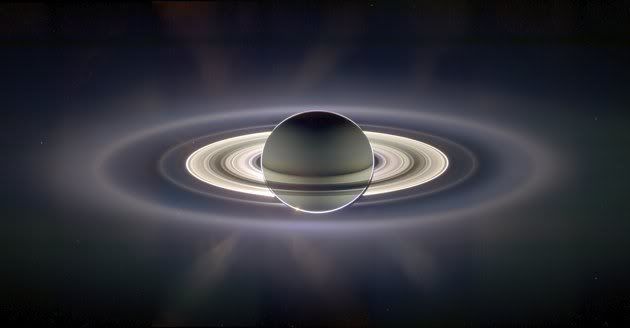
Science fiction movies have spoiled us on high definition views of our planetary neighbors, but real-life photographs with equal jaw-dropping potential are exceedingly rare. That's what makes NASA's awe-inspiring snapshot of Saturn (hi-res version here) such a stunning piece of eye candy.
Taken by NASA's Cassini robotic orbiter, the shot was captured from the dark side of Saturn as the Sun's bright rays illuminated every piece of dust and debris circling the planet. Cassini has offered astronomers a never-before-seen look at Saturn and revealed more information about the planet than any craft before it. The craft has taken so many pictures of the ringed wonder that they were recently made into a short flyby film that looks like it was created by George Lucas rather than a robotic space explorer.
The Cassini probe was launched in 1997 and took a further 7 years to reach Saturn's orbit. The total cost of its overarching objective of studying the ringed planet stands at a staggering $3.26 billion. However, the wealth of information it has wrought — including amazing pictures like the one above, and recordings of massive lightning storms on the planet — have already made it one of the best investments in space exploration. Hopefully Juno — which began a 5-year trek to Jupiter just last month — will bring us some equally stunning shots of Saturn's neighbor.
Article By :Mike Wehner, Thu, Sep 8, 2011
Dead NASA satellite will soon plummet to Earth

A dead NASA satellite will soon fall to Earth, but the space agency says there is very little chance that a piece of it will hit someone.
NASA says the 20-year-old satellite will probably fall sometime between late September and October. Pieces of it could land anywhere in the six inhabited continents in a worldwide swath from south of Juneau, Alaska, to just north of the tip of South America. NASA scientists estimate a 1-in-3,200 chance a satellite part could hit someone. Most of it will burn up after entering Earth's atmosphere.
The 6-ton (5.4-metric ton) Upper Atmosphere Research Satellite (UARS) ran out of fuel in 2005 and will fall uncontrolled out of orbit. Only about 1,200 pounds (544.32 kilograms) of metal should survive, NASA said.
This satellite is far smaller than the 135-ton (123-metric ton) Russian space station Mir, which fell to Earth in 2001 or the 100-ton (91-metric ton) Skylab that fell in 1979. Mir fell into the South Pacific, while Skylab hit the Indian Ocean and parts of sparsely populated western Australia. Because two-thirds of the Earth is ocean, space debris usually hits water
"Things have been re-entering ever since the dawn of the Space Age; to date nobody has been injured by anything that's re-entered," said NASA orbital debris chief Gene Stansbery. "That doesn't mean we're not concerned."
NASA now has a rule that the chance of any of its satellites hitting someone has to be more than 1 in 10,000. But UARS, which measured chemicals in the air, was launched in 1991 before that rule was adopted. The agency usually tries to put dead satellites into "a graveyard orbit" or steer them down to the ocean, Stansbery said. But there was not enough fuel in this one to fire engines that would move it to a higher orbit or steer it down safely.
The 1-in-3,200 odds of being hit pertain to any of the nearly 7 billion people on Earth. But any one individual's odds of being struck are about 1 in 21 trillion.
Space debris bigger than 5 tons (4.5 metric tons) does not often fall to Earth. But this will be the third time this year for something that big to reach Earth, according to Jonathan McDowell, a Harvard University astrophysicist who tracks objects in orbit.
The UARS satellite travels over a large band of Earth, avoiding only areas close to the poles. NASA calculates that when the satellite does fall it will scatter pieces over a 500-mile (800-kilometer)-wide region.
Stansbery said the agency doesn't know exactly when and where those will fall because it depends on the orientation of the satellite in the atmosphere, solar storm activity and other variables.
There probably is no hazardous material left in the falling pieces, but people should not touch any fallen satellite parts just in case, he said.
NASA will be tracking the satellite on a weekly and later daily basis until it falls.
Article by :SETH BORENSTEIN - AP Science Writer | Sep 9, 2011
~~~~~~~~~~~~~~~~~~~~~~~~~~~~~~~~~~~~~~~~~~~~~~~~~~~~~~~~~~~~~~~~~~~~~~~~~~
AFP News – Sat, Sep 17, 2011
US satellite may crash back to Earth Sept 23: NASA
This undated NASA image shows a conceptual image of the Upper Atmosphere Research Satellite (UARS), launched in September 1991, by the space shuttle Discovery.
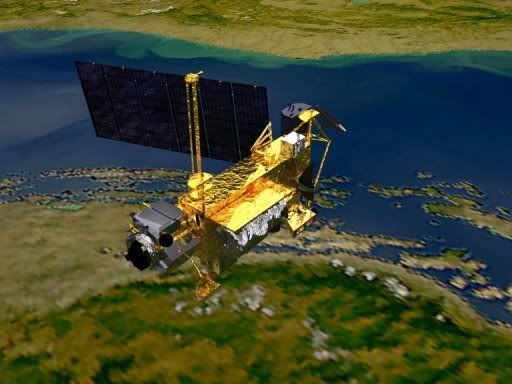
A 20-year-old satellite that measured the ozone layer is expected to crash back to Earth late next week, but NASA said it still does not know where it will fall.
The US space agency stressed that the risk to public safety from the Upper Atmosphere Research Satellite (UARS) is "extremely small," and said that most, but not all, of the gear will burn up on re-entry into Earth's atmosphere.
"Re-entry is expected Sept. 23, plus or minus a day. The re-entry of UARS is advancing because of a sharp increase in solar activity since the beginning of this week," NASA said in a brief update on its website on Friday.
"Safety is NASA's top priority," it added, noting that throughout history, there have been "no confirmed reports of an injury resulting from re-entering space objects."
The decommissioned satellite could land anywhere between 57 degrees north latitude and 57 degrees south latitude, a vast swath of populated territory. Predictions will only get more precise as the landing approaches.
The UARS satellite was sent into orbit in 1991 by the space shuttle Discovery.
The 35 by 15 foot (three by 10 meter) spacecraft weighed 13,000 pounds (5,900 kilograms) and toted 10 scientific instruments for measuring wind, temperature and ozone chemistry. It was officially decommissioned in 2005.
"Although the spacecraft will break into pieces during re-entry, not all of it will burn up in the atmosphere," NASA said.
"It is impossible to pinpoint just where in that zone the debris will land, but NASA estimates the debris footprint will be about 500 miles (800 kilometers) long," the space agency said.
It also urged anyone who comes across what they believe may be space debris not to touch it, but to call authorities for assistance.
Monday, August 22, 2011
The Strangest Alien Planets
By SPACE.com Staff @ 17 May 2011
The Smallest

Credit: NASA
This artist's concept of Kepler-10b shows the smallest known exoplanet, announced in January 2011.
The Former Champ

Credit: ESO/L. Calcada
Gliese 581 e used to hold the title of smallest alien planet. However, it was dethroned in January 2011, with the announcement of Kepler-10b.
The Biggest
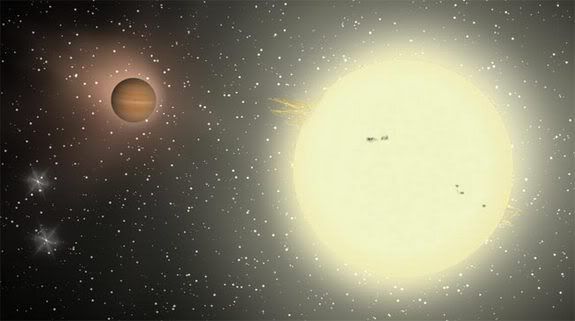
Credit: Jeffrey Hall, Lowell Observatory
The largest exoplanet ever discovered is also one of the strangest and theoretically should not even exist, scientists say. Dubbed TrES-4, the planet is about 1.7 times the size of Jupiter and belongs to a small subclass of so-called puffy planets that have extremely low densities. The planet is located about 1,400 light years away from Earth and zips around its parent star in only three and a half days
Closest Alien World to Us
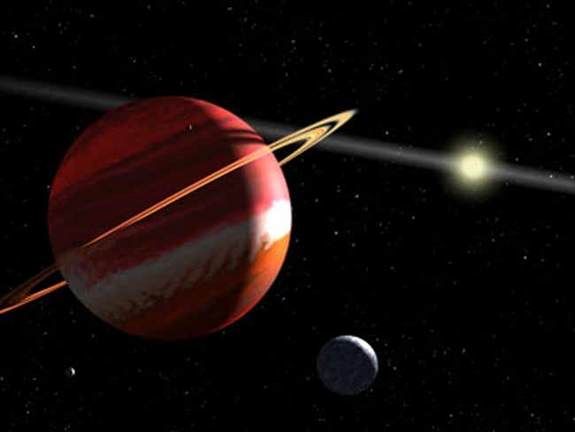
Credit: NASA, ESA, G.F. Benedict (University of Texas, Austin)
Epsilon Eridani b orbits an orange Sun-like star only 10.5 light years away from Earth. It is so close to us telescopes might soon be able to photograph it. It orbits too far away from its star to support liquid water or life as we know it, but scientists predict there are other stars in the system that might be good candidates for alien life.
Volcanic Nightmare
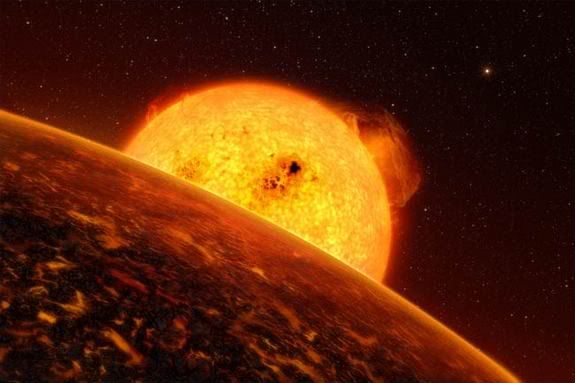
Credit: ESO/L. Calcada
This planet, CoRoT-7b, was the first confirmed rocky world outside our solar system, but it doesn't look like a particularly pleasant place to live. It is tidally locked to its parent star, sees hellish 4,000 degrees Fahrenheit (2,200 degrees Celsius). It may also rain rocks and be the core of a vaporized gas giant.
Multiple Sunsets Like Tatooine
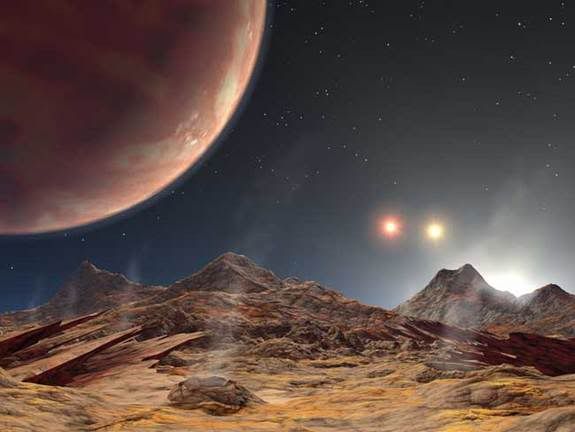
Credit: NASA/JPL's Planetquest/Caltech
Luke Skywalker’s home planet of Tatooine in Star Wars had two suns, but that’s paltry compared to a Jupiter-like planet 149 light-years from Earth. This planet has three suns, with the main star similar in mass to our own sun. The triple-star system is known as HD 188753. Like Tatooine, the planet there is likely pretty hot – it orbits very close to the main star, completing one orbit every 3.5 days.
Coldest and Farthest From Us
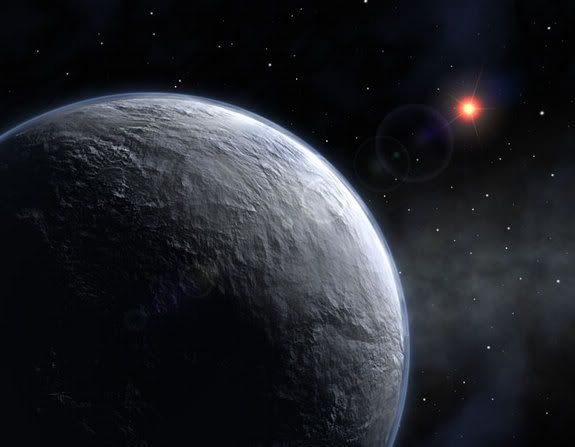
Credit: ESO
With a surface temperature of -364 degrees Fahrenheit (-220 degrees Celsius), the extrasolar planet known as OGLE-2005-BLG-390L b is likely the coldest alien world. It is about 5.5 times as massive as Earth and thought to be rocky. It orbits a red dwarf star about 28,000 light-years away, making it the most distant exoplanet currently known.
Hottest World

Credit: ESA/NASA/Frederic Pont, Geneva University Observatory
A planet called WASP-12b is the hottest planet ever discovered (about 4,000 degrees Fahrenheit, or 2,200 degrees Celsius), and orbits its star closer than any other known world. It orbits its star one every Earth day at a distance of about 2 million miles (3.4 million km). WASP-12b is a gaseous planet, about 1.5 times the mass of Jupiter, and almost twice the size. It is 870 light-years from Earth
Super-Earth
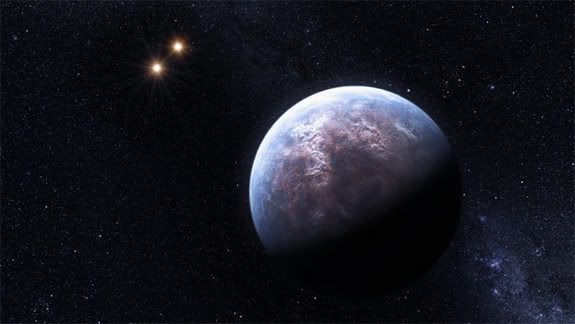
Credit: ESO
Astronomers are finding many worlds now in a category of worlds called Super-Earths, which are between 2 and 10 times the mass of our own Earth. Some scientists think such worlds could be more susceptible to forming the conditions for life because their cores are hot and would be conducive to geological upheaval through volcanism and plate tectonics
Oldest Alien Planet
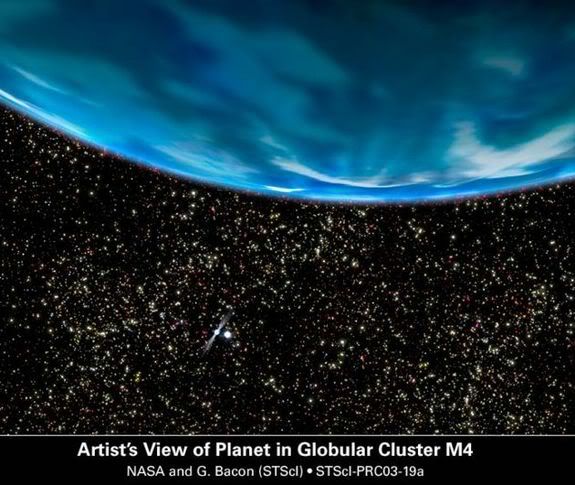
Credit: NASA and H. Richer (U. British Columbia)
The oldest known planet is a primeval world 12.7 billion years old that formed more than 8 billion years before Earth and only 2 billion years after the Big Bang. The discovery suggested planets are very common in the universe and raised the prospect that life began far sooner than most scientists ever imagined.
The Youngest Known Exoplanet
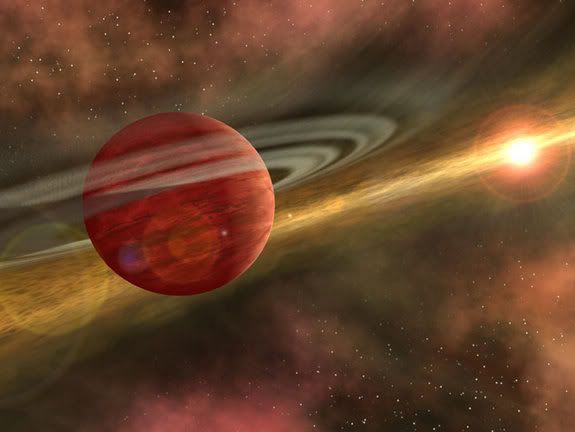
Credit: NASA
The youngest exoplanet yet discovered is less than 1 million years old and orbits Coku Tau 4, a star 420 light-years away. Astronomers inferred the planet’s presence from an enormous hole in the dusty disk that girdles the star. The hole is 10 times the size of Earth’s orbit around the Sun and probably caused by the planet clearing a space in the dust as it orbits the star.
The Puffiest
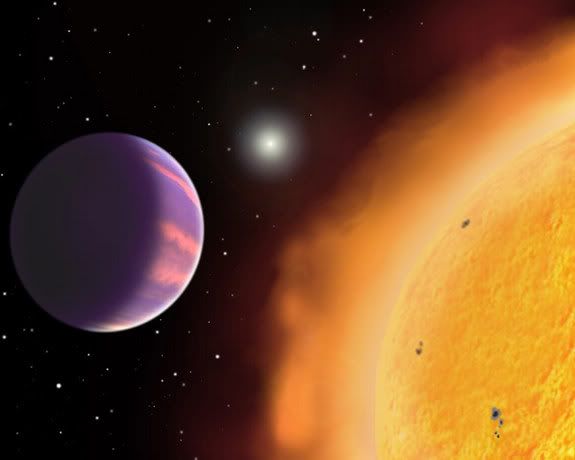
Credit: David A. Aguilar/Harvard-Smithsonian Center for Astrophysics
A planet lighter than a ball of cork is one of the puffiest alien planets known to date. Called HAT-P-1, the planet is about half as massive as Jupiter but about 1.76 times wider-or 24 percent larger than predicted by theory. It could float in water, if there was a tub large enough to hold it.
Super Neptune
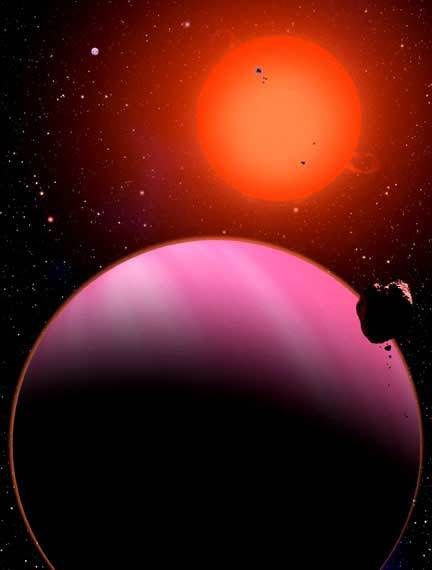
Credit: David A. Aguilar, CFA
While Neptune has a diameter 3.8 times that of Earth and a mass 17 times Earth's, the new world (named HAT-P-11b) is 4.7 times the size of Earth and has 25 Earth masses. The newfound world orbits very close to its star, revolving once every 4.88 days. As a result, it is baked to a temperature of around 1100 degrees F.
The star itself is about three-fourths the size of our Sun and somewhat cooler.
Tilted World
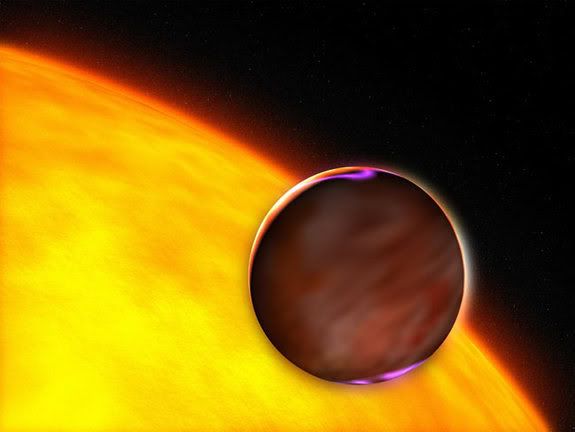
Credit: NASA. ESA, amd G. Bacon (STScI)
Most planets orbit in a plane that corresponds to their parent star's equator. But XO-3b orbits with a crazy tilt of 37 degrees from its star's equator. The only other known example of such an oddly angled orbit was Pluto, until its demotion
to dwarf planet status. There is, however, a planet known to orbit backwards around its parent star.
Fastest Planet
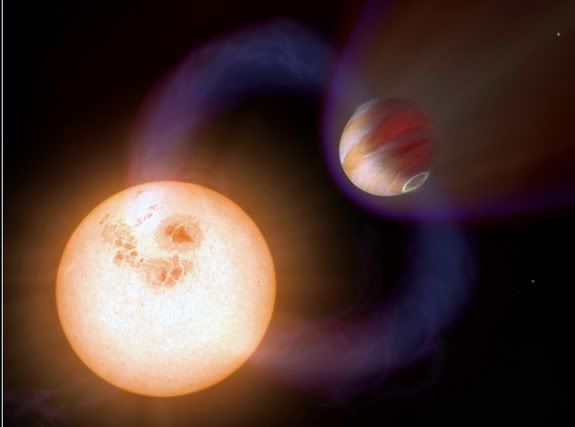
Credit: NASA, ESA, A. Schaller (for STScI)
SWEEPS-10 orbits its parent star from a distance of only 740,000 miles, so close that one year on the planet happens every 10 hours. The exoplanet belongs to a new class of zippy exoplanets called ultra-short-period planets (USPPs), which have orbits of less than a day.
Waterworld
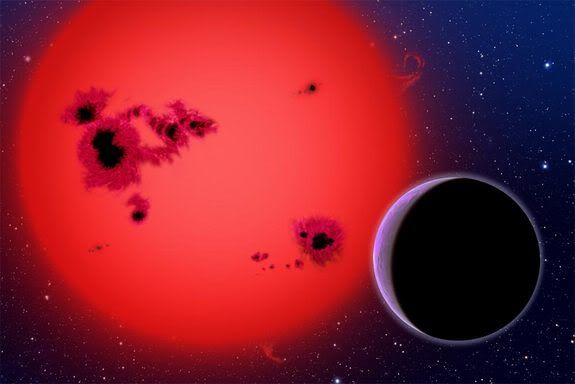
Credit: David A. Aguilar, CFA
The extrasolar planet GJ 1214b is a rocky planet rich in water that sits about 40 light-years away. It orbits a red dwarf star. It is the only known "Super-Earth" exoplanet — worlds that have masses between Earth and Neptune — with a confirmed atmosphere. The planet is about three times the size of Earth and about 6.5 times as massive. Researchers think it is likely a water world with a solid center.
Atmosphere Detected
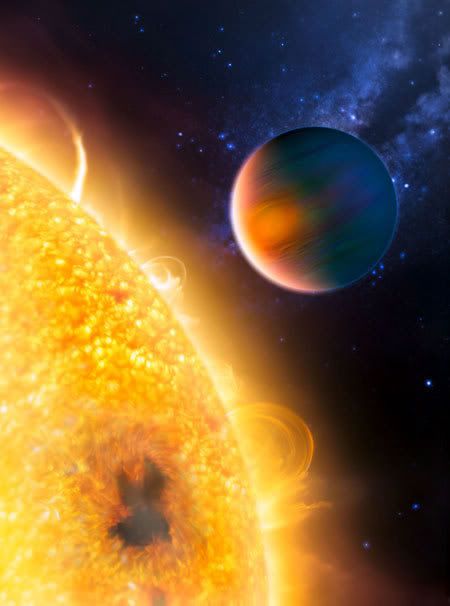
Credit: ESA, NASA and G. Tinetti
Astronomers have been able to detect the atmospheres around several exoplanets, including HD 189733b – one of the first alien words to have its atmosphere sniffed to determine its composition. Glowing methane, which can be produced naturally or be a biological byproduct, has been detected on the planet.
Endangered World
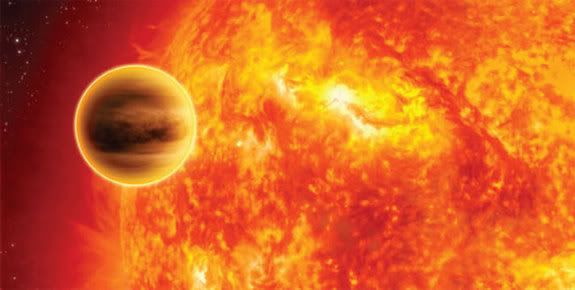
Credit: CARREAU/ESA/Nature
When astronomers observed WASP-18b, they may have seen it in the cosmic moment before its death. This planet, possibly an ill-fated world, whips around its star in less than one Earth day. Scientists think that this speed coupled with the planet's heft yields strong gravitational tugs that can alter the planets orbit. If the planet orbits faster than its star spins, it should gradually be moving inward towards its sun, and its doom.
Most Habitable
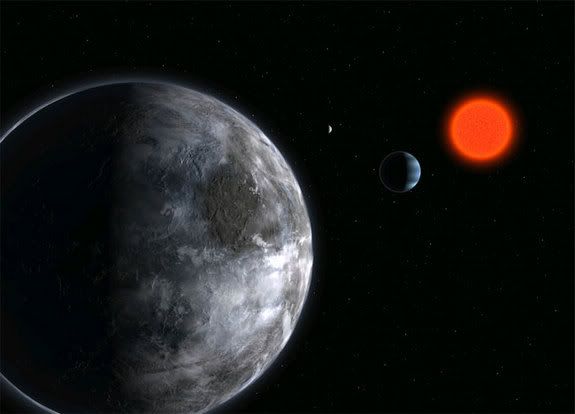
Credit: ESO
One of the several planets within the Gliese 581 star system, called Gliese 581 d, may be one of the most potentially habitable alien worlds known. It is about 8 times the mass of Earth, and located in an orbit just right for liquid water to exist on the surface. Water is a key ingredient for life as we know it. Gliese 581 is a red dwarf star 20.5 light-years from Earth
Densest Planet
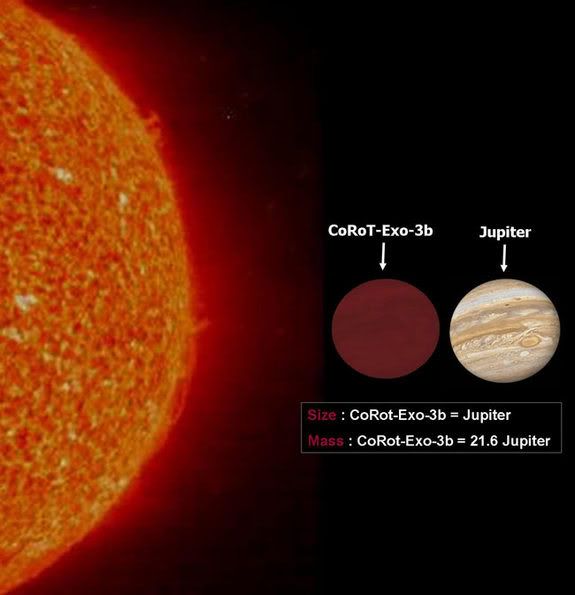
Credit: ESO/OAMP
One of the densest exoplanet to date is a world known as COROT-exo-3b. It is about the size of Jupiter, but 20 times that planet’s mass, making it about twice as dense as lead. Scientists have not ruled out that the COROT-exo-3b may be a brown dwarf, or failed star.
The Smallest

Credit: NASA
This artist's concept of Kepler-10b shows the smallest known exoplanet, announced in January 2011.
The Former Champ

Credit: ESO/L. Calcada
Gliese 581 e used to hold the title of smallest alien planet. However, it was dethroned in January 2011, with the announcement of Kepler-10b.
The Biggest

Credit: Jeffrey Hall, Lowell Observatory
The largest exoplanet ever discovered is also one of the strangest and theoretically should not even exist, scientists say. Dubbed TrES-4, the planet is about 1.7 times the size of Jupiter and belongs to a small subclass of so-called puffy planets that have extremely low densities. The planet is located about 1,400 light years away from Earth and zips around its parent star in only three and a half days
Closest Alien World to Us

Credit: NASA, ESA, G.F. Benedict (University of Texas, Austin)
Epsilon Eridani b orbits an orange Sun-like star only 10.5 light years away from Earth. It is so close to us telescopes might soon be able to photograph it. It orbits too far away from its star to support liquid water or life as we know it, but scientists predict there are other stars in the system that might be good candidates for alien life.
Volcanic Nightmare

Credit: ESO/L. Calcada
This planet, CoRoT-7b, was the first confirmed rocky world outside our solar system, but it doesn't look like a particularly pleasant place to live. It is tidally locked to its parent star, sees hellish 4,000 degrees Fahrenheit (2,200 degrees Celsius). It may also rain rocks and be the core of a vaporized gas giant.
Multiple Sunsets Like Tatooine

Credit: NASA/JPL's Planetquest/Caltech
Luke Skywalker’s home planet of Tatooine in Star Wars had two suns, but that’s paltry compared to a Jupiter-like planet 149 light-years from Earth. This planet has three suns, with the main star similar in mass to our own sun. The triple-star system is known as HD 188753. Like Tatooine, the planet there is likely pretty hot – it orbits very close to the main star, completing one orbit every 3.5 days.
Coldest and Farthest From Us

Credit: ESO
With a surface temperature of -364 degrees Fahrenheit (-220 degrees Celsius), the extrasolar planet known as OGLE-2005-BLG-390L b is likely the coldest alien world. It is about 5.5 times as massive as Earth and thought to be rocky. It orbits a red dwarf star about 28,000 light-years away, making it the most distant exoplanet currently known.
Hottest World

Credit: ESA/NASA/Frederic Pont, Geneva University Observatory
A planet called WASP-12b is the hottest planet ever discovered (about 4,000 degrees Fahrenheit, or 2,200 degrees Celsius), and orbits its star closer than any other known world. It orbits its star one every Earth day at a distance of about 2 million miles (3.4 million km). WASP-12b is a gaseous planet, about 1.5 times the mass of Jupiter, and almost twice the size. It is 870 light-years from Earth
Super-Earth

Credit: ESO
Astronomers are finding many worlds now in a category of worlds called Super-Earths, which are between 2 and 10 times the mass of our own Earth. Some scientists think such worlds could be more susceptible to forming the conditions for life because their cores are hot and would be conducive to geological upheaval through volcanism and plate tectonics
Oldest Alien Planet

Credit: NASA and H. Richer (U. British Columbia)
The oldest known planet is a primeval world 12.7 billion years old that formed more than 8 billion years before Earth and only 2 billion years after the Big Bang. The discovery suggested planets are very common in the universe and raised the prospect that life began far sooner than most scientists ever imagined.
The Youngest Known Exoplanet

Credit: NASA
The youngest exoplanet yet discovered is less than 1 million years old and orbits Coku Tau 4, a star 420 light-years away. Astronomers inferred the planet’s presence from an enormous hole in the dusty disk that girdles the star. The hole is 10 times the size of Earth’s orbit around the Sun and probably caused by the planet clearing a space in the dust as it orbits the star.
The Puffiest

Credit: David A. Aguilar/Harvard-Smithsonian Center for Astrophysics
A planet lighter than a ball of cork is one of the puffiest alien planets known to date. Called HAT-P-1, the planet is about half as massive as Jupiter but about 1.76 times wider-or 24 percent larger than predicted by theory. It could float in water, if there was a tub large enough to hold it.
Super Neptune

Credit: David A. Aguilar, CFA
While Neptune has a diameter 3.8 times that of Earth and a mass 17 times Earth's, the new world (named HAT-P-11b) is 4.7 times the size of Earth and has 25 Earth masses. The newfound world orbits very close to its star, revolving once every 4.88 days. As a result, it is baked to a temperature of around 1100 degrees F.
The star itself is about three-fourths the size of our Sun and somewhat cooler.
Tilted World

Credit: NASA. ESA, amd G. Bacon (STScI)
Most planets orbit in a plane that corresponds to their parent star's equator. But XO-3b orbits with a crazy tilt of 37 degrees from its star's equator. The only other known example of such an oddly angled orbit was Pluto, until its demotion
to dwarf planet status. There is, however, a planet known to orbit backwards around its parent star.
Fastest Planet

Credit: NASA, ESA, A. Schaller (for STScI)
SWEEPS-10 orbits its parent star from a distance of only 740,000 miles, so close that one year on the planet happens every 10 hours. The exoplanet belongs to a new class of zippy exoplanets called ultra-short-period planets (USPPs), which have orbits of less than a day.
Waterworld

Credit: David A. Aguilar, CFA
The extrasolar planet GJ 1214b is a rocky planet rich in water that sits about 40 light-years away. It orbits a red dwarf star. It is the only known "Super-Earth" exoplanet — worlds that have masses between Earth and Neptune — with a confirmed atmosphere. The planet is about three times the size of Earth and about 6.5 times as massive. Researchers think it is likely a water world with a solid center.
Atmosphere Detected

Credit: ESA, NASA and G. Tinetti
Astronomers have been able to detect the atmospheres around several exoplanets, including HD 189733b – one of the first alien words to have its atmosphere sniffed to determine its composition. Glowing methane, which can be produced naturally or be a biological byproduct, has been detected on the planet.
Endangered World

Credit: CARREAU/ESA/Nature
When astronomers observed WASP-18b, they may have seen it in the cosmic moment before its death. This planet, possibly an ill-fated world, whips around its star in less than one Earth day. Scientists think that this speed coupled with the planet's heft yields strong gravitational tugs that can alter the planets orbit. If the planet orbits faster than its star spins, it should gradually be moving inward towards its sun, and its doom.
Most Habitable

Credit: ESO
One of the several planets within the Gliese 581 star system, called Gliese 581 d, may be one of the most potentially habitable alien worlds known. It is about 8 times the mass of Earth, and located in an orbit just right for liquid water to exist on the surface. Water is a key ingredient for life as we know it. Gliese 581 is a red dwarf star 20.5 light-years from Earth
Densest Planet

Credit: ESO/OAMP
One of the densest exoplanet to date is a world known as COROT-exo-3b. It is about the size of Jupiter, but 20 times that planet’s mass, making it about twice as dense as lead. Scientists have not ruled out that the COROT-exo-3b may be a brown dwarf, or failed star.
10 Wildest Tries to Contact Aliens
By InnovationNewsDaily Staff
@ 05 May 2011
Since we have developed the technology, we’ve been sending messages into space ― from scientists, rock stars, students, politicians ― in the hopes that someone or something will hear them and respond. That practice of broadcasting is known as Messaging Extraterrestrial Intelligence (METI). Here are some of the messages that we have beamed into the cosmos in an attempt to get E.T.'s attention.
The Arecibo message

Credit: Cornell University
Beamed out 37 years ago, the Arecibo message is still the most powerful broadcast ever deliberately beamed into space. It was sent from Cornell University’s Arecibo radio telescope in Puerto Rico.
The transmission was aimed at the globular star cluster M13. The cluster is roughly 21,000 light-years from us, near the edge of the Milky Way galaxy, and contains approximately a third of a million stars.
Researchers worked together to create a message that contained basic information about Earth and the life it contained. It including a graphic of the Arecibo telescope, our solar system, human DNA, a stick figure of a human, and some of the biochemicals of earthly life.
The message took only three minutes to transmit, and so far, we haven’t heard back.
Pioneer 10 and 11
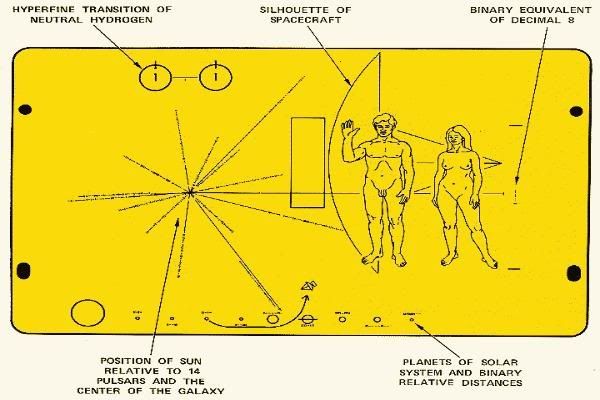
Credit: NASA
Pioneer 10 was the first spacecraft to reach Jupiter, Saturn, and beyond the solar system toward other stars. Soon afterward, Pioneer 11 followed its exact flight pattern, and presumably they’re still going, though we have lost contact.
Knowing that these two crafts would make it so far into space and would be traveling for years to come, NASA attached plaques to both Pioneer 10 and 11 with information about Earth.
The 6- by 9-inch gold anodized plaques were bolted to the spacecrafts’ frames; they depict a man – whose right hand is raised as a sign of good will – and woman. In addition, they show the layout of our solar system, as well as our sun’s position relative to a number of pulsars are shown, so that our location can be triangulated from fixed points in space. The hope is that the beings who find it can figure out whence the probe came.
Pioneer 10 was the first spacecraft to reach Jupiter, Saturn, and beyond the solar system toward other stars. Soon afterward, Pioneer 11 followed its exact flight pattern, and presumably they’re still going, though we have lost contact.
Knowing that these two crafts would make it so far into space and would be traveling for years to come, NASA attached plaques to both Pioneer 10 and 11 with information about Earth.
The 6- by 9-inch gold anodized plaques were bolted to the spacecrafts’ frames; they depict a man – whose right hand is raised as a sign of good will – and woman. In addition, they show the layout of our solar system, as well as our sun’s position relative to a number of pulsars are shown, so that our location can be triangulated from fixed points in space. The hope is that the beings who find it can figure out whence the probe came.
Voyagers’ golden record
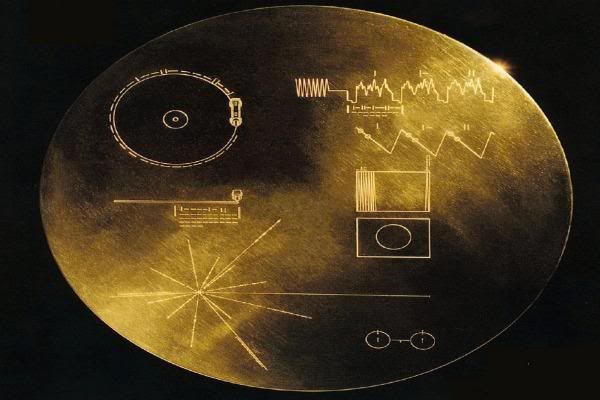
Credit: NASA
Four years after Pioneer 11 was launched, Voyager 1 and Voyager 2 were sent out to explore Jupiter and Saturn, and NASA decided to take their message to the next level.
Voyager 1 and 2 contain a “time capsule” that, according to NASA, was “intended to communicate a story of our world to extraterrestrials.” The Voyager message is carried on a 12-inch gold-plated copper phonograph disk containing sounds and images selected to portray the diversity of life and culture on Earth.
After the section that contains the sounds of Earth, the record’s creators included a 90-minute section of music that includes both Eastern and Western classics as well as a selection of ethnic music from all over the planet.
The Voyager spacecrafts left our solar system in 1990, and it will be 40,000 years before they make it close to any other planetary system, so we still have a while to wait before we get a return message.
“A Message from Earth”

Credit: Bebo
While Facebook seems to be the social network that has achieved everything, the honor of being the first one to try to network with extraterrestrial intelligence goes to Bebo, which sent out “A Message from Earth” in 2008.
Some 501 photos, drawings and text messages from the site’s 12 million users were transmitted by the National Space Agency of Ukraine's RT-70 radar telescope, which is normally used to track asteroids. The messages were sent to the planet Gliese 581C, which is 20 light-years from Earth, in the hope they would reach intelligent alien life.
Bebo users submitted their messages as part of a competition, and 501 were translated into a binary format, so they could be sent the 120 trillion miles to the Gliese 581C. According to the competition, the messages could cover any range of topics. They should be reaching their destination in 2028.
Cosmic Calls 1 and 2

Credit: S. Korotky
Cosmic Call 1 and Cosmic Call 2, pictograms broadcast from Moscow toward various star systems, featured the “Interstellar Rosetta Stone.”
The “rosetta stone,”developed by Yvan Dutil and Stephane Dumans, was based on mathematical and scientific concepts believed to be universal. The hope was that any alien life form that intercepted the calls would be able to use it to decipher the messages.
The calls were sent out by Alexander Zaitsev, of the Russian Academy of Science in Moscow to sunlike stars within 70 light-years. The first Cosmic Call was beamed toward four separate star systems, 16 Cyg A, Gliese 777, HD 178428 and 15 Sge. The second, reached out to five stars, including 55 Cancri, which is home to a complex planetary system.
The second message also included 50 personal messages from individuals including David Bowie and elementary students from the Ukraine.
The Teen-Age Message
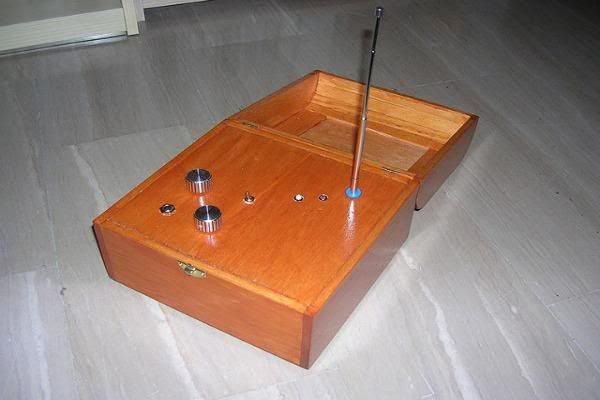
Credit: Farnea via Flickr
In addition to the Cosmic Calls, Zaitsev had his hand in the Teen-Age Message, which was a transmission put together by students from all across Russia.
The TAM transmission was sent out in six sessions in August and September 2001 from the Evpatoria Deep Space Center. It was transmitted to six nearby sunlike stars, some of them with at least one planet.
Like the Arecibo message, TAM had digital information, but Zaitsev and the students decide to include that information in analog format as well, to “compensate for the uncertainty of which is more easily understood by extraterrestrials.”
TAM included personal greetings, messages about Earth, and music that was made with a theremin – the electronic instrument used to make the eerie sounds from 1950s science fiction B-movies.
Doritos commercial

Credit: Doritos
In a 2008 publicity campaign, radars in the Arctic Circle broadcast six hours of a repeating Doritos commercial. Surprisingly, it has not made us targets of an alien attack.
The ad was directed toward a solar system in the Ursa Major constellation, which is only 42 light-years away from Earth. This system has a “habitable zone,” which scientists believe could be host to an Earth-like planet and extraterrestrial life.
The EISCAT European space station on the Norwegian island of Svalbard sent the message using its array of radars. It was sent as an MPEG file coded into 1s and 0s. Researchers agreed that the message would look just like a random series, but they hoped that through its repetition, extraterrestrials would identify the message as intelligent.
RuBisCo message

Credit: U.S. Department of Energy
On the thirty-fifth anniversary of the original Arecibo message, MIT biology fellow and artist Joe Davis sent the genetic code for the plant enzyme RuBisCo into space.
RuBisCo, which is essential for photosynthesis, is the most abundant protein on Earth, which is why Davis selected it to represent life on Earth.
According to Peter Weigele of New England Biolabs, “The choice of this molecule for broadcast communicates the central importance of our sun in sustaining life as well as an implicit understanding of the role of [carbon dioxide] in our biogeochemical systems. This is a message that is both timely and timeless – for the universe and here on Earth!”
This was also the first transmission that required the aid of an iPhone. When Davis arrived at Arecibo, the encoder normally used to modulate the beam was out of commission, so he used his iPhone as an improvised source to get the new coded message modulated into the 1,000-foot-wide dish’s 2-million-watt radio beam.
“Hello from Australia”

Credit: HelloFromEearth/Cosmos Magazine
In 2009, Australia’s Cosmos magazine took a cue from Bebo and reached out to its readers to create a goodwill message to transmit through space.
The magazine’s website collected text-message-length sentiments from people all over the world. The first came from Kim Carr, Australia’s minister for innovation, industry, science and research. It said: “Hello from Australia on the planet we call Earth. These messages express our people’s dreams for the future. We want to share those dreams with you.”
It was sent from the Canberra Deep Space Communication Complex to the planet Gliese 581d ― a planet in the same system as Gliese 581c, which was the recipient of “A Message from Earth.” Australia’s message should be arriving just a year later, in 2010.(original text puts 2029?)
Kepler DVD
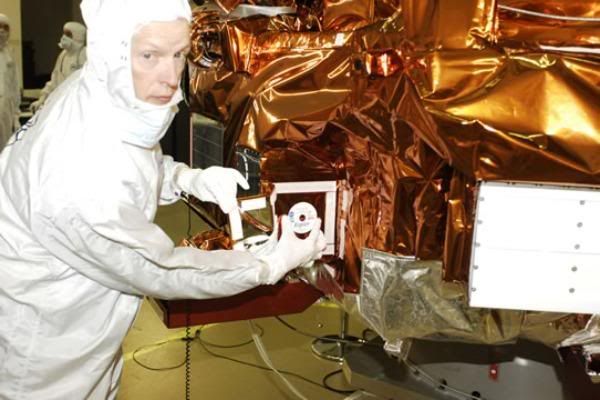
Credit: NASA
In keeping with its earlier messaging practices, NASA included a DVD with the Kepler spacecraft two years ago.
The Kepler was specifically designed to search our region of the Milky Way galaxy for other habitable Earth-size and smaller planets. If by chance it did find life, it had a message.
Unlike the messages from Pioneers 1 and 2 and the Voyager golden record, these messages came from the public. For six-month period, tens of thousands of people submitted messages explaining why the Kepler mission was important. These were then recorded on the DVD, which was attached to the spacecraft.
The spacecraft is still going, so there is still a chance that the message may be discovered.
@ 05 May 2011
Since we have developed the technology, we’ve been sending messages into space ― from scientists, rock stars, students, politicians ― in the hopes that someone or something will hear them and respond. That practice of broadcasting is known as Messaging Extraterrestrial Intelligence (METI). Here are some of the messages that we have beamed into the cosmos in an attempt to get E.T.'s attention.
The Arecibo message

Credit: Cornell University
Beamed out 37 years ago, the Arecibo message is still the most powerful broadcast ever deliberately beamed into space. It was sent from Cornell University’s Arecibo radio telescope in Puerto Rico.
The transmission was aimed at the globular star cluster M13. The cluster is roughly 21,000 light-years from us, near the edge of the Milky Way galaxy, and contains approximately a third of a million stars.
Researchers worked together to create a message that contained basic information about Earth and the life it contained. It including a graphic of the Arecibo telescope, our solar system, human DNA, a stick figure of a human, and some of the biochemicals of earthly life.
The message took only three minutes to transmit, and so far, we haven’t heard back.
Pioneer 10 and 11

Credit: NASA
Pioneer 10 was the first spacecraft to reach Jupiter, Saturn, and beyond the solar system toward other stars. Soon afterward, Pioneer 11 followed its exact flight pattern, and presumably they’re still going, though we have lost contact.
Knowing that these two crafts would make it so far into space and would be traveling for years to come, NASA attached plaques to both Pioneer 10 and 11 with information about Earth.
The 6- by 9-inch gold anodized plaques were bolted to the spacecrafts’ frames; they depict a man – whose right hand is raised as a sign of good will – and woman. In addition, they show the layout of our solar system, as well as our sun’s position relative to a number of pulsars are shown, so that our location can be triangulated from fixed points in space. The hope is that the beings who find it can figure out whence the probe came.
Pioneer 10 was the first spacecraft to reach Jupiter, Saturn, and beyond the solar system toward other stars. Soon afterward, Pioneer 11 followed its exact flight pattern, and presumably they’re still going, though we have lost contact.
Knowing that these two crafts would make it so far into space and would be traveling for years to come, NASA attached plaques to both Pioneer 10 and 11 with information about Earth.
The 6- by 9-inch gold anodized plaques were bolted to the spacecrafts’ frames; they depict a man – whose right hand is raised as a sign of good will – and woman. In addition, they show the layout of our solar system, as well as our sun’s position relative to a number of pulsars are shown, so that our location can be triangulated from fixed points in space. The hope is that the beings who find it can figure out whence the probe came.
Voyagers’ golden record

Credit: NASA
Four years after Pioneer 11 was launched, Voyager 1 and Voyager 2 were sent out to explore Jupiter and Saturn, and NASA decided to take their message to the next level.
Voyager 1 and 2 contain a “time capsule” that, according to NASA, was “intended to communicate a story of our world to extraterrestrials.” The Voyager message is carried on a 12-inch gold-plated copper phonograph disk containing sounds and images selected to portray the diversity of life and culture on Earth.
After the section that contains the sounds of Earth, the record’s creators included a 90-minute section of music that includes both Eastern and Western classics as well as a selection of ethnic music from all over the planet.
The Voyager spacecrafts left our solar system in 1990, and it will be 40,000 years before they make it close to any other planetary system, so we still have a while to wait before we get a return message.
“A Message from Earth”

Credit: Bebo
While Facebook seems to be the social network that has achieved everything, the honor of being the first one to try to network with extraterrestrial intelligence goes to Bebo, which sent out “A Message from Earth” in 2008.
Some 501 photos, drawings and text messages from the site’s 12 million users were transmitted by the National Space Agency of Ukraine's RT-70 radar telescope, which is normally used to track asteroids. The messages were sent to the planet Gliese 581C, which is 20 light-years from Earth, in the hope they would reach intelligent alien life.
Bebo users submitted their messages as part of a competition, and 501 were translated into a binary format, so they could be sent the 120 trillion miles to the Gliese 581C. According to the competition, the messages could cover any range of topics. They should be reaching their destination in 2028.
Cosmic Calls 1 and 2

Credit: S. Korotky
Cosmic Call 1 and Cosmic Call 2, pictograms broadcast from Moscow toward various star systems, featured the “Interstellar Rosetta Stone.”
The “rosetta stone,”developed by Yvan Dutil and Stephane Dumans, was based on mathematical and scientific concepts believed to be universal. The hope was that any alien life form that intercepted the calls would be able to use it to decipher the messages.
The calls were sent out by Alexander Zaitsev, of the Russian Academy of Science in Moscow to sunlike stars within 70 light-years. The first Cosmic Call was beamed toward four separate star systems, 16 Cyg A, Gliese 777, HD 178428 and 15 Sge. The second, reached out to five stars, including 55 Cancri, which is home to a complex planetary system.
The second message also included 50 personal messages from individuals including David Bowie and elementary students from the Ukraine.
The Teen-Age Message

Credit: Farnea via Flickr
In addition to the Cosmic Calls, Zaitsev had his hand in the Teen-Age Message, which was a transmission put together by students from all across Russia.
The TAM transmission was sent out in six sessions in August and September 2001 from the Evpatoria Deep Space Center. It was transmitted to six nearby sunlike stars, some of them with at least one planet.
Like the Arecibo message, TAM had digital information, but Zaitsev and the students decide to include that information in analog format as well, to “compensate for the uncertainty of which is more easily understood by extraterrestrials.”
TAM included personal greetings, messages about Earth, and music that was made with a theremin – the electronic instrument used to make the eerie sounds from 1950s science fiction B-movies.
Doritos commercial

Credit: Doritos
In a 2008 publicity campaign, radars in the Arctic Circle broadcast six hours of a repeating Doritos commercial. Surprisingly, it has not made us targets of an alien attack.
The ad was directed toward a solar system in the Ursa Major constellation, which is only 42 light-years away from Earth. This system has a “habitable zone,” which scientists believe could be host to an Earth-like planet and extraterrestrial life.
The EISCAT European space station on the Norwegian island of Svalbard sent the message using its array of radars. It was sent as an MPEG file coded into 1s and 0s. Researchers agreed that the message would look just like a random series, but they hoped that through its repetition, extraterrestrials would identify the message as intelligent.
RuBisCo message

Credit: U.S. Department of Energy
On the thirty-fifth anniversary of the original Arecibo message, MIT biology fellow and artist Joe Davis sent the genetic code for the plant enzyme RuBisCo into space.
RuBisCo, which is essential for photosynthesis, is the most abundant protein on Earth, which is why Davis selected it to represent life on Earth.
According to Peter Weigele of New England Biolabs, “The choice of this molecule for broadcast communicates the central importance of our sun in sustaining life as well as an implicit understanding of the role of [carbon dioxide] in our biogeochemical systems. This is a message that is both timely and timeless – for the universe and here on Earth!”
This was also the first transmission that required the aid of an iPhone. When Davis arrived at Arecibo, the encoder normally used to modulate the beam was out of commission, so he used his iPhone as an improvised source to get the new coded message modulated into the 1,000-foot-wide dish’s 2-million-watt radio beam.
“Hello from Australia”

Credit: HelloFromEearth/Cosmos Magazine
In 2009, Australia’s Cosmos magazine took a cue from Bebo and reached out to its readers to create a goodwill message to transmit through space.
The magazine’s website collected text-message-length sentiments from people all over the world. The first came from Kim Carr, Australia’s minister for innovation, industry, science and research. It said: “Hello from Australia on the planet we call Earth. These messages express our people’s dreams for the future. We want to share those dreams with you.”
It was sent from the Canberra Deep Space Communication Complex to the planet Gliese 581d ― a planet in the same system as Gliese 581c, which was the recipient of “A Message from Earth.” Australia’s message should be arriving just a year later, in 2010.(original text puts 2029?)
Kepler DVD

Credit: NASA
In keeping with its earlier messaging practices, NASA included a DVD with the Kepler spacecraft two years ago.
The Kepler was specifically designed to search our region of the Milky Way galaxy for other habitable Earth-size and smaller planets. If by chance it did find life, it had a message.
Unlike the messages from Pioneers 1 and 2 and the Voyager golden record, these messages came from the public. For six-month period, tens of thousands of people submitted messages explaining why the Kepler mission was important. These were then recorded on the DVD, which was attached to the spacecraft.
The spacecraft is still going, so there is still a chance that the message may be discovered.
Subscribe to:
Posts (Atom)




















